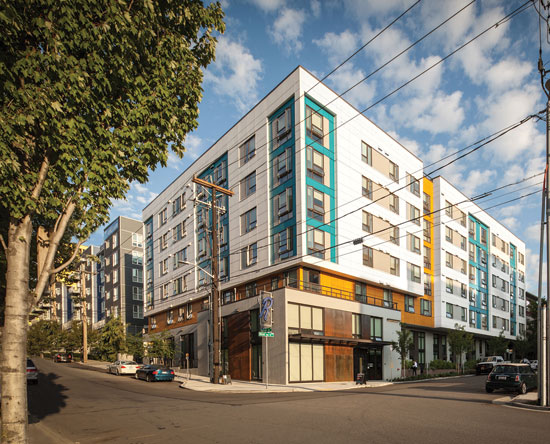Modern Building Codes: Keeping Pace with the Wood Revolution
Wind Resistance
In addition to superior seismic performance, wood buildings can be designed to effectively resist high winds. Wood's elastic limit and ultimate strength are higher when loads are applied for a shorter time period, which is typically the case in high wind events. When structural panels such as plywood or OSB are properly attached to lumber framing and used to form diaphragms and shear walls, they also form some of the most solid and stable roof, floor and wall systems available.8
However, in order for the diaphragms and shear walls to be effective, all of the related components—including framing, structural panel sheathing and inter-element fastening details—must be designed and installed correctly. For the structural system to work as intended, the roof diaphragm must be able to transfer lateral loads to the shear walls and the shear walls themselves must transfer these loads to the foundation. The success of the entire system is only as good as the quality and quantity of the connections. Therefore, the key to constructing a building that can resist lateral loads is understanding how forces are transferred and how to design and install proper connections.
In hurricanes, the loss of roofing materials and sheathing is the leading cause of failure in wood-frame buildings. The most common reasons behind these failures are improper connection detailing between structural systems and inadequate fastening of sheathing to the supporting members. Most local building codes require a minimum of 33 fasteners for a standard 4×8 panel installed over the roof supports at 24 inches o.c. Fasteners, such as 8d common nails (2.5 inches x 0.131 inch) or other code-approved options, should be placed a maximum of 6 inches o.c. along panel edges and 12 inches o.c. at intermediate supports. Following Hurricane Andrew in Florida, damage assessment teams found roof sheathing panels with as few as four fasteners. Once the roof sheathing has been pulled off its framing, the load path is interrupted and the diaphragm ceases to function as part of the lateral load-resisting system. In fact, the entire loading dynamics of the building will have changed due to this breach. This change in loading dynamics negatively affects the lateral design of the building.
With proper detailing, it is relatively easy to meet code requirements for safety during high wind and seismic events. The AWC publication Special Design Provisions for Wind and Seismic (SDPWS) is directly referenced by the IBC for the required design of lateral force-resisting systems such as nailed wood-frame shear walls and diaphragms which resist lateral loads.










